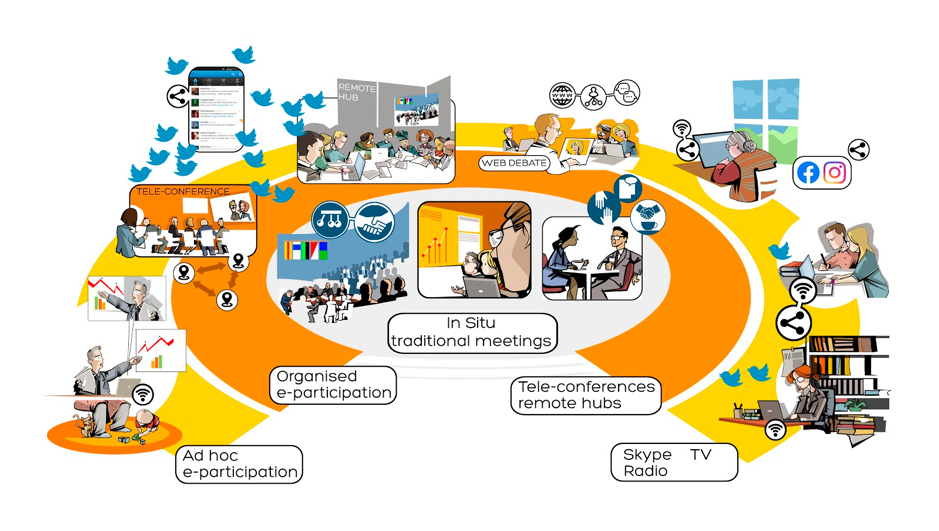The spread of the new coronavirus is testing our globalised world. The world of diplomacy is particularly affected by these developments, as meetings, conferences, and other major events are cancelled.
During times of crisis, international cooperation is more than essential. Driven by necessity, diplomacy is adapting. For the first time, the World Bank and the International Monetary Fund (IMF) will host their Spring Meetings online. The UN, EU and other organisations are moving from conference rooms to online spaces, triggering a profound change in the way diplomacy is conducted.

The accelerated transition towards online meetings and diplomacy requires three major changes:
- Online platforms need to be improved to offer the stability and security required in diplomacy;
- The social face-to-face dynamics need to be adapted to new online dynamics;
- Many of the centuries-old rules of protocol need to be revisited.
A new ‘hybrid diplomacy’ which fuses traditional face-to-face meetings with organised online participation, and ad-hoc online meetings, is emerging quickly.
Read: Diplomacy goes virtual as the coronavirus goes viral
Learn: Online course on Online Meetings for Diplomacy and Global Governance
Are artificial intelligence and data coming to the rescue?
In the wake of the coronavirus outbreak, digital epidemiology is emerging fast. We are witnessing the involvement of major tech actors who are exploring and exploiting the potential of artificial intelligence (AI), big data, and other emerging technologies in predicting, monitoring, and preventing the adverse effects of the crisis.
The use of AI is varied. Researchers are using AI to detect existing drugs that can halt the spread of the virus. AI is being deployed in the form of tiny robots serving food and providing medical help to quarantined people, or as chatbots that screen individuals and tell them whether they should be evaluated in case of possible infection.
The use of data enabled the prediction and identification of the pandemic. Data collected by BlueDot helped provide an early warning about the virus. Similarly, data collected by medical centres on patients’ geographic location and infection situation, used as part of a database known as the National Infectious Disease Monitoring Information System Database, helped Chinese authorities identify the outbreak of the coronavirus.
Online data platforms are being used to track the spread of the pandemic worldwide. One such tool has been developed by the Center for Systems Science and Engineering (CSSE) at Johns Hopkins University, which gathers data from the World Health Organization (WHO), Centers for Disease Control, and the National Health Commission of the People’s Republic of China.
The tool serves to combat what the Washington Post called a pandemic of misinformation about coronavirus. Attempts to regulate virus-related digital content and halt such an ‘infodemic’ have been initiated by both the WHO and major tech companies such as Facebook and Google.
The WHO, for instance, addresses popular myths related to the spread of the disease in its dedicated page on ‘myth busters’. Google’s efforts to address fake news include the activation of an ‘SOS alert’, while Facebook is removing false assertions and virus-related conspiracy theories posted on its social media platforms.
Read more: Coronavirus crisis: A digital policy overview, Digital Watch observatory
Follow: The latest digital policy updates on COVID-19
How do we go from onsite to online?
Online meetings, conferences, and other events are becoming more relevant as COVID-19 spreads and obliges people to respect social distancing rules. Hundreds of events are making the shift from onsite to online for the first time.
With over 15 years of practical experience in e-participation, the team behind Diplo’s Conference Tech Lab suggest a two-step approach. First, one should decide on the type of event to be organised; second, one should choose a platform that fits the specific needs. Additionally, moderation – which depends on a smart blend of old and new skills – should be regarded as the tipping point that creates a unique online experience.
The need to transition from onsite to online goes beyond conferences. Millions of workers have turned to working online, increasing the time spent online, and blurring the line between work and family life. Knowing how to work effectively online can make this transition smoother.
Online learning is also receiving renewed focus, as schools, colleges, and universities are forced to shut their doors. Students and lecturers are turning to interactive platforms and innovative tools to enhance their online learning experience.
Is COVID-19 changing our approach to ‘online’? Most likely. The reduction of carbon footprint and pollution levels, less time spent commuting, and lower travel costs are strong incentives to retaining this new-found kind of (online) normal.
Read: How to organise and run online meetings
Follow: Updates from Diplo’s Conference Tech Lab
Discuss: Join our live webinars to discuss the impact of COVID-19
Learn: Use your time well and take an online course with Diplo
https://www.diplomacy.edu/covid-19#ff2-126














